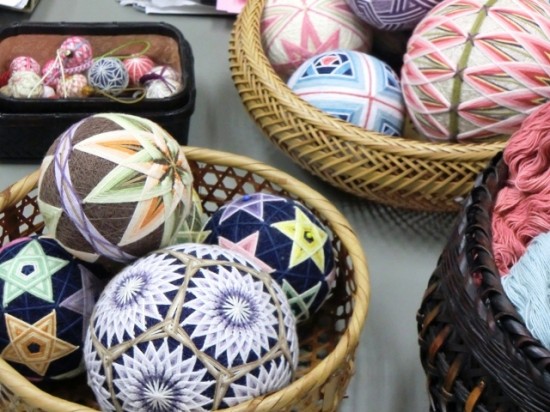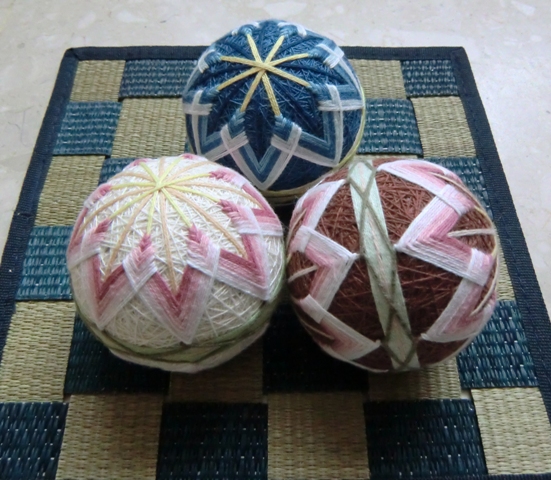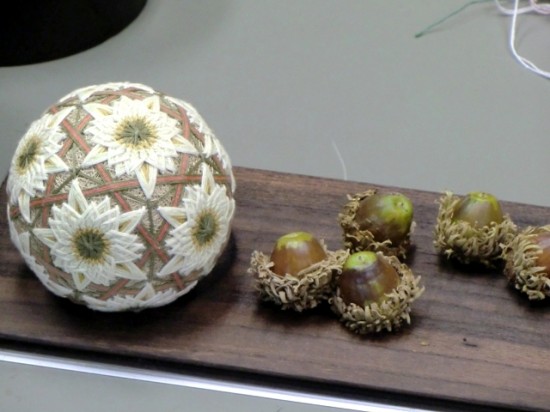We’re moving away from contemporary art for a few posts, to go back to Japanese traditions a bit. Remember, last October, we were in Japan, not only to attend the Setouchi International Art Festival, but also to learn a bit more about the traditions from the Kagawa Prefecture. We started with bonsais and continued with Wasanbon sugar. Our third and last (at least until our next trip to Kagawa) topic is the Sanuki Kagari Temari (讃岐かがり手まり).
“What is that?” you may be wondering.
To answer this question, let’s start with the meaning of these three terms:
-
Sanuki: It simply is Kagawa’s old name, back when it was a province of Japan and not a prefecture yet. This is why one finds many things associated with this term in Kagawa (you may already know Sanuki Udon for example).
-
Kagari: If I understood correctly it simply means “to sew up”.
-
Temari: It literally means “hand ball” (not the sport). Those balls were introduced into Japan from China a little more than 500 years ago. For a long time, they simply were used as toys. Nowadays, they’re usually used as decorative objects.
So I guess, you know a little more about them now, but not much more…
Maybe a picture will help?
A few words about this history of Temari:
As I told you, Temari came to Japan from China about 500-600 years ago. First, they were reserved to the elites – the aristocracy and the samurais – as they were made from silk and as such unaffordable for the common people. However, during the Edo Period, some people started to make Temari from cotton. And, as you may or may not know, it just so happens that cotton was one of the main natural resources of the Sanuki Province. So, people from the area started to make cotton Temari and the region became one of the main producers in Japan.
First, those Temari were extremely simple in design, they weren’t much more than balls made from cotton threads. Then, little by little, using threads dyed with natural colorants, people started making Temari with more complex designs, giving them looks similar to the silk ones of the nobles. They kept on becoming more and more popular to the point that by the end of the Edo Period, cotton Temari could be found all over Japan.
During the Meiji and Taishō Periods, one can talk about a golden age of the Temari. With the industrialization of cotton mills, Temari became even more common to the point they became an integral part of Japanese culture. There even were songs about them!
But with the continuation of Japan’s modernization, balls made of rubber soon appeared in the country and quickly replaced the Temari that quickly became obsolete as toys. At the beginning of the Shōwa Period, the production of cotton Temari had completely ceased.
After the war, Mr. Kazuo Araki, from the town Kan’Onji, in the Western part of Kagawa, while doing research about people’s every day life in the past, became interested in the now disappeared cotton Temari. So, he started doing research about them and interviewed former manufacturers. With the help of Yaeko, his wife, who was a kimono maker and who also made various traditional decorative objects, they decided to try making cotton Temari, just like in the old days. However, the endeavor proved to be much harder than originally expected as some of the manufacturing techniques and secrets were lost, especially the recipes for the various dyes that used to all be made from local roots, flowers, leaves and other plants.
So, they travelled to various places in Japan were Temari used to be made, especially Matsumoto, to learn about the techniques from those places. They did not only learn how to master those techniques, but they also did a real archivist and historian work about these balls. And after 30 years of learning, researching and practicing, they finally reconstituted the traditional techniques from the Sanuki Province and they succeeded into resuscitating the local Temari that they renamed Sanuki Kagari Temari.
Today, Sanuki Kagari Temari are considered as official Traditional Art Objects (a title that protects them and their techniques if I understood correctly) and the Sanuki Kagari Temari Hozonkai organization is in charge of their protection as well as their promotion. Nowadays, Ms. Eiko Araki, Kazuo & Yaeko Araki’s daughter in law, is at its head. The organization’s mission obviously includes preserving the manufacturing techniques of the Sanuki Kagari Temari, but also to simply make them so that people from Kagawa (as well as the rest of Japan) can rediscover them and learn about them.
A very beautiful initiative in a Japan that’s losing its traditions more and more.
Sources: Big thanks to Sanuki Kagari Temari Hozonkai and to Eiko Araki for welcoming us and giving us those information (that are also on their website if you can read Japanese) as well as 康代 for translating it.



Interesting post!
Thank you very much for sharing – I’ve seen temari balls before (admittedly mostly in photos), but had no idea about the history surrounding them. Thanks! ^^
You’re very welcome. Actually, you need to thank my wife (I’ll tell her), had it not been for her and her desire to learn more about her traditional culture, I wouldn’t even know they exist. And I must admit that if at first I was not thrilled to spend my afternoon watching women sewing balls, it ended up being a enriching experience. There’s actually a second post coming about them! (later today or tomorrow) Stay tuned.
Thanks for this! A woman once gave me some handmade kagari temari on the bus, but I never knew the history of them. Interesting!
You’re welcome!
People give you presents on the bus?
Thank you so much for an interesting and beautiful post about temari. I have the new book Sanuki Temari. Unfortunately, I do not read Japanese and can only enjoy the lovely photos.
I am coming to Kyoto and Tokyo next fall and hope to meet with temari makers.
You’re very welcome.
I don’t know if there are any Temari makers in Tokyo or Kyoto, but now, you know where to find some on Shikoku.
I love these temari! Nice photos of them, too.
If you like Temari, stay tuned, I’ll have a surprise pertaining to them in a few weeks.
Learning about them certainly heighten my level of appreciation towards it.:)
I totally agree with you. First time I saw them, I didn’t really pay attention to them. It’s only after learning about them that I understood how incredible they were.
I’m just learning Temari and have quickly fallen in love with this art form. I didn’t know about it’s background, so thank you for a very interesting post.
Hello Bonnie.
Thanks for stopping by and for the kind word.
I am always happy to see temari getting some attenion. This is the passion which drives my life!